|
Okay, if
you don't learn something new in this section, I'll give you all your money
back.
For people
who are still noodling around with the letters and stalling their decision
of choosing their best-fit type, here's a reason to get on with it. This
area of study plunges one into the deepest exploration of Type imaginable -- but
you can't mine it fully until you "own" a Type code!
Let's begin
with the basics: what's an archetype, and what does it to have to do with
your personality? Here is Carl Jung's complicated explanation:
The
concept of the archetype, which is an indispensable correlate to the idea of
the collective
unconscious, indicates the existence of definite forms in the psyche which
seem to be present always and everywhere. Mythological research calls them
"motifs"; in the psychology of primitives they correspond to Levy-Bruhl's
concept of "representations collectives," and in the field of
comparative religion they have been defined by Hubert and Mauss as
"categories of the imagination." Adolf Bastian long ago called them
"elementary" or "primordial thoughts." From these
references, it should be clear enough that my idea of the archetype --
literally a pre-existent form -- does not stand alone, but is something that
is recognized and named in other fields of knowledge.
My
thesis, then, is as follows: In addition to our immediate consciousness, which
is of a thoroughly personal nature and which we believe to be the only
empirical psyche (even if we tack on the personal unconscious as an appendix),
there exists a second psychic system of a collective, universal, and
impersonal nature which is identical in all individuals. This collective
unconscious does not develop individually, but is inherited. It consists of
pre-existent forms, the archetypes, which can only become conscious
secondarily and which give definite form to certain psychic contents.
Archetypes
are thus the powerful symbolic images that inform our view of heroes, wise men,
mothers, and villains, among others. We encounter them in many aspects of our
daily lives -- in art, religion, movies, and even cartoons! The bad guy
invariably dresses in black; the good guy in white (and he is always strong and
kind). Mothers are nurturing, gentle, and protective. The wise man is often
portrayed as a white-haired old man with a frail body and peaceful demeanor.
These images are recognizable by most of us, and there are strong similarities
in these symbols even from one culture to the next. They are so pervasive
that archetypes are anchored in our brain structure and occupy the "middle ground"
between mind and matter. Archetypes are what provide the deep structure for human
motivation and meaning. Whenever archetypes are encountered in art, literature,
sacred texts, and advertising—or in individuals or groups—they evoke
emotional resonance and become the unconscious frameworks that determine how and
why people think and react. Pretty powerful stuff, huh?
Let me
preface what I write next by explaining that I personally have never embraced
archetypes. They just didn't do anything for me. I slogged dutifully
through Clarissa Pinkola Este's Women Who Run with the Wolves, and while I
found some of it very moving, overall I just couldn't relate to it all
that much. It was simply lost on me. I wrote it off as something
inaccessible -- something other types (especially INFPs) got into, but not
me. Ho hum. Next!
It turns
out I'm not alone. Anne Singer Harris has this to say about them:
Archetypes
tend to shift shape and flow into each other... This is because archetypes are
content-free, patterned tendencies of thought; their qualities overlap, they
are not hierarchical, and their symbolic expression is complexly
layered. This is a messy and unpredictable realm in which to wander, and
its shiftiness annoys people who like to call a spade a spade and never a
shovel. ...To tolerate these conditions, a person must tolerate
ambiguity.
...which I
confess is not my favorite thing, especially given my interaction style...
Then Dr.
Linda Berens introduced me to the John Beebe* model, and showed me how to
"map" archetypes to the Type model.
Wow.
I still
don't understand archetypes all that well, but I'm playing catch-up as fast as I
can. The effort seems worth it now.
To access
Dr. Beebe's model, you have to update any old-fashioned thinking you harbor
about Type. Type of the "old school" scenario claims people really only
access their dominant function and a little bit of their auxiliary. The
code is notated thus: INFJ. That notation implies introverted N and
extraverted F are about the only things you've got going for you, since those
are the only letters you see.
I hope to turn that concept on its ear for you.
Dr. Beebe
basically "doubled" Jung's personality functions by adding the Shadow
(unacceptable) aspects of each function. So "New
School" Type thinking claims that we all possess and actively use all eight
of the type functions. They're all available in each person's personality
toolbox. However, we utilize them in vastly different ways and for vastly
different purposes. My extraverted Feeling stapler is another person's
extraverted Feeling ice-pick, if you follow the metaphor.
Now let's
revisit that Type code: INFJ. That code implies the following
hierarchy of functions (per the alternating function method I embrace):
Ni Fe Ti Se Ne Fi Te Si. That list displays my preferred order of
functions. And, if you read the section on Individuation, you know these
functions develop more fully throughout our lives as we mature (though Dr.
Beebe says the functions don't necessarily individuate sequentially**).
Here's a
new wrinkle: the first four functions listed above are what Dr. John Beebe
calls "ego-syntonic." That means when we access these functions,
we are in "synch" with them. They feel comfortable, they come
naturally to us, and we feel "normal" when we use them. When we
access them, our "ego" says, "Yep, that's me."
What about
those last four functions?
Dr. Beebe
calls those functions "ego-dystonic." That means those functions
do not come as easily or naturally to us, and we do not feel "normal"
when we use them -- in fact, we feel like we're alien, not ourselves. When
we access them, our ego says, "Who was that? That doesn't feel
right. That's not like me!"
As a
result, we naturally tend to be more deft and graceful at using our first four
functions than our last four functions.
To take
this understanding a step further, we may automatically dislike or reject
persons who prefer to use our "ego-dystonic" functions. This results in
the ever-popular "personality conflict," without anyone ever doing
something provocative. (Sometimes I wonder why God
"hard-wired" us for conflict this way, unless it's his master plan for
forcing us all to move out of our comfort zones and learn adapting skills.)
It's useful
to note here that the definition of "Type opposite" comes up for grabs
with this model. The tendency has been for us to suppose that the opposite
of an INFJ is an ESTP because the codes have no letters in common. But the
fact is that both codes contain identical preferences for the first four
functions, albeit in opposite order. For an INFJ: Ni Fe Ti Se, and for an
ESTP: Se Ti Fe Ni. See? Same codes, opposite orders. So it's common to see INFJs and ESTPs attracted to one
another and getting along famously (many of them married!). According to
Dr. John Beebe, it is most difficult for people of the same primary function but
opposite attitude to get along, and the greatest personal conflicts arise
between persons of opposite genders who have the same dominant function but
paired with opposite attitudes. Again for an INFJ: Ni Fe Ti Se, and now
for NFPs: Ne Fi Te Si -- no matches anywhere! Also with STJs: Si Te Fi Ne
-- the same mismatching.
Taking this
natural pattern of hostility to its obvious extreme could account for war.
Jung believed that aggression on a collective level (war) could result from failure to take responsibility
for aggression on a personal level by persons who refuse to recognize their own
Shadow aspects. (The Shadow is "the thing a person has no wish to be.") So when we
attack and blame another person for carrying our Shadow -- for being different,
and for manifesting our ego-dystonic functions -- we see that person (or nation) as
the cause of all our ills and disappointments. If they in turn do the
same, we begin attacking each other in the name of making the world better, and
a downward spiral is set in motion.
Let's do
our part to reverse that trend and start by revisiting Type codes again: INFJ. Instead of representing
Type via
this succinct code, or with a litany of letters (Ni Fe Ti Se Ne Fi Te Si), the
Type code is
sometimes displayed as a hierarchy:
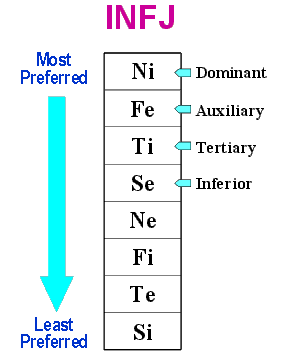
So those
are most of the ways we typically see Type represented.
In
contrast, Dr. Beebe's model is better likened to Eric Berne's Transactional
Analysis. Do you remember that pop psychology movement? This diagram
might ring a bell:

Now let me
show you those same ego states, but mapped to an INFJ's favorite functions:

This
mapping shows you what "archetypal role" an INFJ's preferred three
functions play in the personality. When we access these functions, we
simultaneously invoke the archetypal role associated with that function, and
speak from that place.
Now you
could stop right here and you'd already have a whole new layer of richness added
to the Type model. But let's add more dimension.
Eric
Berne's model got interesting when it was used to analyze interactions between
two people (thus the term "transactional analysis"). To show you
what that might look like related to Type, I will add a mapping of an ENTP's
favorite three functions and show you how communication transacts between an
ENTP and an INFJ.
The
function addressing the other person becomes a "heat-seeking missile,"
searching out its match in the other person's hierarchy. So an INFJ's Fe
seeks out the matching Fe of an ENTP, and invokes its associated role. In
the following transaction, the INFJ's Fe "Parent" speaks to the ENTP's
Fe "Child." And, for a different transaction, the ENTP's Ti
"Parent" speaks to the INFJ's Ti "Child." Watch how
the functions hone in on each other, but the role the function plays in the
personality changes.
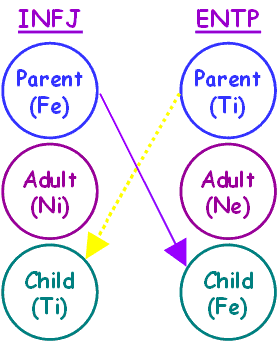
As you may
recall from Transactional Analysis, the most successful communications were
always Adult-to-Adult, or communications that mapped straight across, not at an
angle. Observing the direction of the arrows in the above diagram gives
you a hint that either person might feel "talked down to" in each exchange. So this gives you an inkling of how a perfectly rational
interaction might easily go off the rails.
Once you
grasp this simplified pattern, let's move on to more complicated material.
Get ready to dive really deep! It's time to introduce Beebe's complex "mapping."
The first four (ego-syntonic)
functions will appear on crossed axes thus:

So what's the
purpose of this mapping? Well, by logical extension it should rearrange
your thinking about how the functions operate. The hierarchy is gone,
and it's easy to "slide" back and forth on an axis. Each
function that is on the same axis operates in "tandem," meaning they
work together -- with one function taking primacy and the second function
working in the background (think bicycle wheels).
Let's make
this relevant by showing it associated with preferences for INFJ:
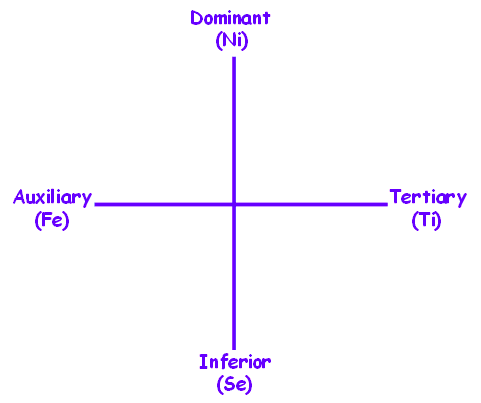
In this
model, the vertical axis operates as the "spine" of the
personality. Now here is a very important concept to grasp: while
the dominant function is at the top of the axis, notice how the
"inferior" function supports it. The inferior function suddenly
snaps into view as the "anchor" of the personality, and this function
cradles many of the personality's aspirations. Rather than operating as a
repository of shame and inadequacy (as it is usually portrayed), it is re-cast as a
source of pride and inspiration. The so-called "inferior"
function now becomes a storehouse of purpose and represents the personality's
highest value. (It may take you some time to take that notion in,
especially if you've learned to "demonize" your inferior function.)
The
horizontal axis displays what are called the "arms" of the personality.
As with the vertical axis, the auxiliary and tertiary functions also operate in tandem,
and together these four functions round out our preferred
personality functions.
The
vertical axis is an "irrational" axis, since both functions are
perceiving ones; and the horizontal function is a "rational" axis,
since both functions are judging ones. (Note: "rational"
means that it is a function under conscious control, while
"irrational" means the function is not. We may control our
judging functions, but it is nearly impossible to control our perceiving
functions. Example: what's that old mind trick about "Don't think
about elephants!"?)
To continue
building the INFJ model, in like fashion, the remaining four (ego-dystonic) functions
will be positioned on axes thus:
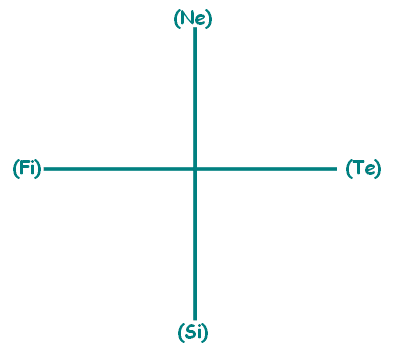
So there's
a whole new way of mapping for you to take in -- with no hierarchies, no
particular order, and a whole new way of expressing Type. Pretty
different, hunh?
These last
four functions are the antithesis of the first four functions, and may be
regarded as manifesting your Shadow. If the first quaternity is composed
of all the behaviors you most admire, then the Shadow quaternity includes all the qualities
you loathe and repudiate. Shadow characteristics are highly emotional with a
possessive quality. (You don't have the Shadow; the Shadow has you.)
The Shadow functions all serve power, aggression,
and excitement. Shadow is mostly unconscious, and you either project it onto others or disown it
("I'm not myself right now"). It may also make itself known
through feelings of self-doubt. The only way you can cope with the Shadow is to
accept this negative side of yourself and forfeit any attempts to appear
faultless.
Now what
about this archetype business I brought up in the beginning?
I haven't
forgotten it, but this material is so radical and rich that you may experience overload.
If you push ahead, you may wish to revisit this section again later, because it's just too
overwhelming to take in with one reading.
I will
now take
this new representation of crossed axes and correlate it to Dr. Beebe's archetypal model. Rather than using the
terms "dominant," "auxiliary," etc., we replace these
terms with the names of specific archetypes that characterize the behaviors
associated with their respective positions. (Note that the Dominant and
Auxiliary names of archetypes are in English because they are the most conscious functions,
while the remaining two are Latinized because they are relatively
unconscious.) All the functions are "trainable" except the
inferior function, which resists conscious control and must be approached
indirectly.
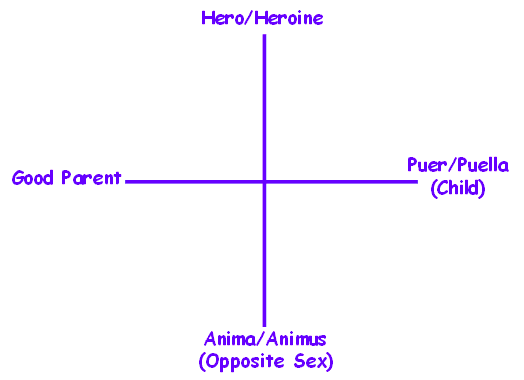
And so on
for the ego-dystonic axes:

This is the
model in its "pure" form as it relates to every type code.
Now let's
associate these archetypes to the personality of an INFJ. (Notice how I
will erect the ego-dystonic axes behind the ego-syntonic axes -- to represent its Shadow
presence.) This is the preferred representation of the Type code using the
Beebe model (as
opposed to the representations I listed off at the beginning of this essay).
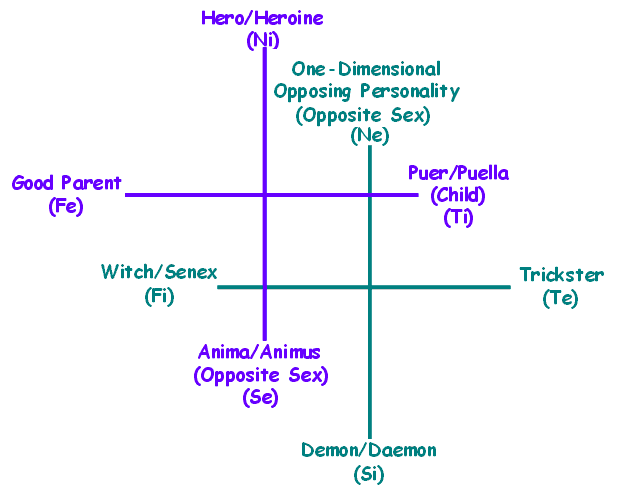
Voila!
a whole new way of looking at the Psychological Type code. The quaternity in front is
ego-syntonic, and the quaternity in back is ego-dystonic, but all eight
functions are accessible. What makes each personality type representation unique is
defining which functions are associated with which archetypes.
So let's
dig deeper into understanding these archetypal associations, shall we? (You might wish
to make some notes and jot down some thoughts for yourself. If possible,
take your time and treat this like a "workbook" as you go through the
material. Otherwise you'll skip relating it to yourself and risk this
powerful material getting mentally filed as unremarkable blather.)
Hero/Heroine:
introverted iNtuition for the INFJ
What does this mean? For an INFJ, the function of Ni acts as the hero. It's how we "save the day." Ni is the
function that is our "Ego Achiever," and is the main protagonist in
our journey through life. It's helpful if you're familiar with Joseph
Campbell and his research into "The Hero's Journey." The Hero
represents the aspect of our personality with which we meet the expectations of
our parents or for socially recognized achievement.
Now it's
your turn. Can you think of ways your Ni has been "heroic" or
saved the day? Once you do, you have begun connecting your Type to your
archetype.
Good
Parent: extraverted Feeling for the INFJ
What does this mean? For an INFJ, the function of Fe acts as the
"Good Parent," also known as the wise old man or woman. This is how you take care of others.
The good parent fosters, enables, and gives permission to do things. It
may nudge you toward what is best for you rather than what you want.
Caring is frequently expressed through this archetype in a helpful voice of wisdom and experience,
and you may rely on the Good Parent's support under all conditions.
Now your
turn. Ask yourself how you would care for a person in deep distress.
Does an extraverted Feeling choice come to mind? If it does, you have just
connected your auxiliary function to an archetypal expression.
Puer/Puella
(child): introverted Thinking for the INFJ
What does this mean? For an INFJ, the function of Ti is a reservoir of
creativity known as the eternal child. It also represents spirituality,
youthful enthusiasm, and new beginnings. On the downside, this Child never
grows up, doesn't have its feet on the ground, can't hang onto a job or
relationship, and repeatedly crashes as a result of flying too high. It
may express itself through new
beginnings, and so is the enemy of a settled life.
I know one
way INFJs sometimes experience Ti is through trying to find precisely the right
word to express something (oh the hours I've wasted getting an email "just
right"!). I also derive endless enjoyment from applying the type
model. In this regard, Dr. John Beebe claims
that the Tertiary function can have narcissistic undertones -- for instance,
when people use tertiary introverted thinking narcissistically, it is usually
when one word or idea or interpretation that it has come up with begins to
dominate one's way of understanding, so that one can no longer take new or
contradictory ideas in. He posits that fixating on one relatively valid idea
which needs to be further unpacked is typical of introverted thinking in the
third position, and one could even go so far as to call that a narcissistic
attachment to that one idea, or that way of using introverted thinking, at the
expense of a more differentiated and evolving thinking, which is more truly open
to other ideas. (The term "closed-minded" springs to mind.)
Your turn
again. Where does your creativity come from? When you "shake
up" your life and start something new, can you identify Ti as the initiator
of it? Do you ever struggle to find just the "right word"?
Are you overly attached to any single word/idea/model/interpretation? What
are you closed-minded about? (Warning: religious fanatacism can emanate from this position.)
Anima/Animus:
extraverted Sensing for the INFJ
What does this mean? Paradigm shift alert! It's important to recognize that Beebe radically
departs from traditional Type theory in his representation of the inferior
function. This function gets lived as an individual's purpose in life; their inspiration, ideal, or "cause" that represents a person's
highest value. When operating in this position, the individual is
inspired as if by a mythological muse. In an INFJ's case, the normal goal of introverted iNtuition is to sense gestalts.
On the same axis, extraverted
Sensing will prompt INFJs to express their iNtuition (or their sense of gestalts) in
some kind of concrete fashion in the real world; to make some idea
"real."
What about
you? What "itch" does extraverted Sensing just have to
scratch? What kinds of "hands-on" activities are you attracted
to? What dreams are you compelled to make reality? Are you the
kind of person who isn't satisfied with talking, but are driven to
accomplish? If so, you have probably discovered your archetypal
"anchor," and gotten in touch with the inspiration that drives your
personality.
Now onto
the second quaternity -- the ego-dystonic functions. (Cue Twilight Zone
theme music.) We now move into the Shadow realm.
Fifth
position Opposing Personality: extraverted iNtuition for the INFJ
What does this mean? This is the shadow of the Hero, the "origin of
obscure or stubborn refusals of life's challenges. The Opposing
Personality can be adversarial, passive-aggressive, suspicious, or
avoidant." It arises as a way to defend oneself, and sometimes
impersonates our opposite gender. This archetype is Dr. Beebe's unique invention,
and he characterizes it as "the terrible twos," when we throw fierce
and desperate temper tantrums.
What about
you? Do you negatively express extraverted iNtuition? Sometimes I
do. I enjoy some forms of brainstorming, but in other situations I just
want to scream "Stop it!" It can quickly get on my nerves, and a
whole LOT of opposing personality comes to the fore if I get too big a dose of
it (especially when I'm focused on Time & Task!).
Sixth
position Witch/Senex: introverted Feeling for the INFJ
What does this mean? This is the bad mother/father that criticizes,
condemns, immobilizes, or demoralizes. It finds fault with everyone,
making everyone seem like fakes or untrustworthy. It can be the basis of self-attacks
commonly experienced in depression. This archetype is anti-life, since it
cripples soul and spirit. The appearance of this function forces one to be
creative, to outwit some challenge by finding a way around it.
What about
you? Do you react negatively to introverted Feeling? I know I
struggle with it. This is a function that causes me a lot of problems (not least
the fact that it's my husband's Tertiary). While I desperately need
it to sort out my values and to provide an internal compass, I also consider
introverted Feeling "selfish," irrational, and unreasonable at times, better dismissed and
ignored.
Seventh
position Trickster: extraverted Thinking for the INFJ
What does this mean? This is the ambiguous shadow of the Puer/Puella.
It can lead you treacherously astray. It fools
and confuses people who encounter you, and its hallmark is to put other people
in double binds.
And
you? How's your relationship with extraverted Thinking? Boy is mine
ever shaky! (And it's my husband's Auxiliary!) In my household, I am
often trapping my husband with "tricky" double binds, probably as a
response to his extraverted Thinking. I often get emotionally upset and
even cry when I am required to access this function.
Eighth
position Demon/Daemon: introverted Sensing for the INFJ
What does this mean? "This is the most rejected aspect of
personality, the source of evil in many people, and (more rarely) the deepest
source of creative inspiration." In a nutshell, for INFJs this is the biggest,
ugliest achilles heel of them all. It is the most deeply unconscious part of our
personal unconscious. It may show up as a destructive creativity that
seems to delight in destroying the old while only occasionally creating
something new.
Your
turn. How do you do with introverted Sensing? I confess I'm still
grappling with this, so don't think I have all the answers, but I'm notorious
for skipping meals or sleeping irregular hours, which invariably catches up with
me in some really awful way -- like an emotional outburst after my blood sugar
hits a dangerously low level. I confess that my house is usually a mess,
and I'm out of touch with my physical body (PMS always takes me by completely
surprise, as if it's the first time that ever happened to me). I also don't react well to some facts --
like when customer service cites fine print at me until I fly off the
handle. And I get extremely cranky when I can't recall something I think I
should, or I recall it inaccurately. Listening to anyone stroll down
"memory lane" tends to leave me cold -- and when my mother recites
"begats" around the family tree, I struggle to keep from
screaming. Usually when you are really "wiggy"
is when your "Demonic" function is in play. (I'm still struggling to identify it
in INFJs --
feel free to write and tell me your observations!)
So that's a
quick and dirty orientation to archetypes as they map to the type
model. It's up to you to study yourself and your own situational behaviors
to discover how they exhibit and play
out in reality.
What's
really exciting is to contemplate how the two functions that sit on the same
axis work in tandem with each other. For instance, I know it's possible
for me to get caught in "analysis paralysis" if an event upsets me and
I start shuttling back and forth on the Fe/Ti "arms" axis. I
visit the Fe function and think about the situation, and then I slide over to Ti
and start tirelessly analyzing my feelings and what happened until the whole thing gets analyzed
to death -- and then I slide back to Fe and start the process all over
again. Brain lock! It's really awful to get trapped in this
unproductive loop.
By the same
token, I see the interplay between my dominant and my inferior function on the
axis "spine" as capturing the hallmark of who I am. I've always
tried to be a person of integrity, and when I have an inspiring vision I am simply
compelled to bring it into reality. This model captures that essence in a
way that Type theory has never done for me before.
A radical thing
to bear in mind here is that we speak from one of these eight archetypal
positions at all times. As John Beebe says, "All type is expressed
through archetype; and all archetype is expressed through type." So when we address someone, a couple of interesting
things might
happen. First, the other person may not "hear" us, or will ask
us to re-issue the communication through a function that is ego-syntonic to
them, thus putting us on their "wavelength." They may be
insistent about getting us to "speak their language." (Dr. Beebe
likens this to using a "trump card" in a card game.)
The second
alternative is that the other person will switch
to match our function (and attitude). When they do, they also switch into the archetypal
position this function occupies in their hierarchy. So when I address my INTJ husband with my
extraverted Feeling (Good Parent), he too switches to extraverted Feeling (his
Trickster). Right out of the gate we're off to a rocky start. And his
introverted Feeling (Puer/Puella) triggers my introverted Feeling (Witch/Senex).
The diagram below shows a couple of possible interactions:
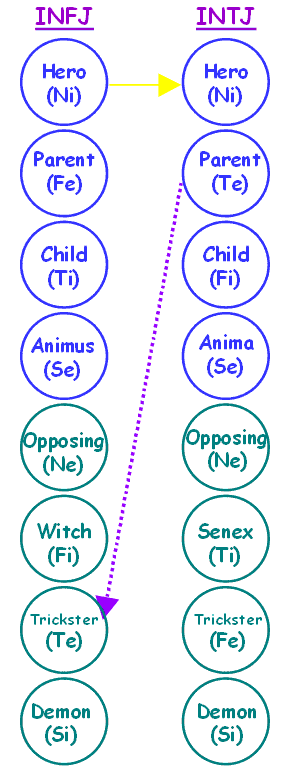
Relationships
and interactions become a whole lot richer and juicier when you employ this
model to investigate how you operate in the world.
This new and unorthodox
mapping can be difficult to get used to at first, especially if you're
conversant and comfortable with the old model. I urge you to spend some
time thinking about it and applying it to yourself, because the rewards of working
with it are enormous, as my husband and I will both attest. It deepens
the notion of Type to a rich level where you confront both the positive and
negative aspects of your personality (and others'), and it can facilitate an
exploration of how you
"mix" with other personalities. I promise that investigating and adopting
this model is worth all the effort, and you will derive greater enjoyment from
working with Type than you did before once you try it. Let me know how you
like it. Good luck, and
enjoy!
concept
& quotes taken from Living
with Paradox, by Anne Singer Harris
* * *
Now that
you've taken a spin around the Beebe model, would
you like to grapple with Dr. Linda Berens' variation of it? It's here.
-------------------
*John
Beebe, M.D., is a Jungian analyst, editor of the San Francisco Jung Library
Journal, co-editor of the Journal of Analytical Psychology, and an
expert on Jung's psychological types. While
many people have become familiar with psychological types as a way of examining
the differences between people, Dr. Beebe has been pioneering their use
intrapsychically as a way to explore the depths of the psyche. You can
find an interview with him here.
**Dr.
Beebe believes the processes develop more or less sequentially thus: 1, 2, 3, 7,
4, 5, 8, 6.
* * *
| ![]()
![]()